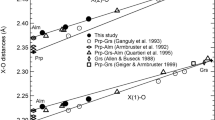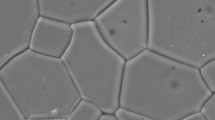Abstract
Physical properties and the crystallization behavior of natural diaplectic labradorite glass of the shocked anorthosite from the Manicouagan impact crater have been studied. Glasses prepared by laboratory fusion of this anorthosite and a synthetic An55 plagioclase composition were used for comparison. The close similarities in the mid-and far-infrared spectra of the diaplectic and fused glasses indicate a comparable degree of short-range order and lack of long-range order in their structures. They also show an identical viscosity-temperature relation, reflecting a similar and probably high degree of coherence of the (Si,Al)O4 tetrahedra in the network. However, striking differences exist in the crystallization characteristics. Diffusion-controlled crystallization takes place in the fused glass between about 900 and 1,400° C and proceeds generally by the advance of dendritic crystal layers from the surface into the interior of the samples. By contrast, diffusion plays a minor, if any, role in the crystallization of the diaplectic glass, which, on annealing between 800 and 1,000° C reverts to the original plagioclase structure and the primary mineral grains are restored.
From the present experimental results it is suggested that high shock-induced temperatures cause onset of the melting process in the compressed crystalline labradorite. However, due to the extremely short duration of the transient high-temperature excursions, the crystal-melt transition does not come to completion. Instead, a disordered transitional state of the compressed material is frozen-in which is recovered after pressure release as diaplectic glass. Its structure thus represents a frozen-in disordered state intermediate between the structures of the crystalline labradorite and its melt. It appears that the diaplectic glass structure is rather inhomogeneous, thereby reflecting the heterogeneous deformational and thermal conditions associated with shock compression.
Similar content being viewed by others
References
Ahrens TJ, Rosenberg JT (1968) Shock metamorphism: Experiments on quartz and plagioclase. In: French BM, Short NM (eds) Shock metamorphism of natural materials. Mono Book Corp, Baltimore, pp 59–81
Ahrens TJ, Petersen CF, Rosenberg JT (1969) Shock compression of feldspars. J Geophys Res 74:2727–2746
Amrhein EM (1970) Defektinduzierte Absorption glasiger und kristalliner Silicate im fernen Infrarot. Glastech Ber 43:1–5
Arndt J, Häberle F (1973) Thermal expansion and glass transition temperatures of synthetic glasses of plagioclase-like compositions. Contrib Mineral Petrol 39:175–183
Bergeron CG, Russell CK (1965) Nucleation and growth of lead titanate from a glass. J Am Ceram Soc 48:115–118
Brückner R, Demharter G (1975) Systematische Untersuchungen über die Anwendbarkeit von Penetrationsviskosimetern. Glastech Ber 48:12–18
Bunch TE, Cohen AJ, Dence MR (1967) Natural terrestrial maskelynite. Am Mineral 52:244–253
Bunch TE, Cohen AJ, Dence MR (1968) Shock-induced structural disorder in plagioclase and quartz. In: French BM, Short NM (eds) Shock metamorphism of natural materials. Mono Book Corp, Baltimore, pp 613–621
Cranmer D, Uhlmann DR (1981) Viscosities in the system albiteanorthite. J Geophys Res 86:7951–7956
Dworak U (1969) Stoßwellenmetamorphose des Anorthosits vom Manicouagan Krater, Quebec, Canada. Contrib Mineral Petrol 24:306–347
Gibbons RV, Ahrens TJ (1977) Effects of shock pressures on calcic plagioclase. Phys Chem Minerals 1:95–107
Grady DE, Murri WJ, DeCarli PS (1975) Hugoniot sound velocities and phase transformations in two silicates. J Geophys Res 80:4857–4861
Grady DE (1977) Processes occurring in shock wave compression of rocks and minerals. In: Manghnani MH, Akimoto SI (eds) High-pressure research. Academic Press, New York San Francisco London, pp 389–438
Grady DE (1980) Shock deformation of brittle solids. J Geophys Res 85:913–924
Iishi K, Tomisaka T, Kato T, Umegaki Y (1971) Isomorphous substitution and infrared and far infrared spectra of the feldspar group. Neues Jahrb Mineral Abh 115:98–119
Kirkpatrick RJ, Klein L, Uhlmann DR, Hays JF (1979) Rates and processes of crystal growth in the system anorthite-albite. J Geophys Res 84:3671–3676
Lofgren G (1974) An experimental study of plagioclase morphology. Am J Sci 273:243–273
Mashimo T, Nishii K, Soma T, Sawaoka A (1980) Some physical properties of amorphous SiO2 synthesized by shock compression of α quartz. Phys Chem Minerals 5:367–377
Maurer RD (1957) Pressure effects in the transformation range of glass. J Am Ceram Soc 40:211–214
Phinney WC, Dence MR, Grieve RAF (1978) Investigation of the Manicouagan impact crater, Quebec: An introduction. J Geophys Res 83:2729–2735
Ringwood AE, Reid AF, Wadsley AD (1967) High pressure transformation of alkali aluminosilicates and aluminogermanates. Earth Planet Sci Lett 3:38–40
Schneider, H (1978) Infrared spectroscopic studies of experimentally shock-loaded quartz. Meteoritics 13:227–234
Stöffler D (1972) Deformation and transformation of rock-forming minerals by natural and experimental shock processes: I. Behavior of minerals under shock compression. Fortschr Mineral 49:50–113
Stöffler D (1974) Deformation and transformation of rock-forming minerals by natural and experimental shock processes. II. Physical properties of shocked minerals. Fortschr Mineral 51:256–289
Stöffler D, Hornemann U (1972) Quartz and feldspars glasses produced by natural and experimental shock. Meteoritics 7:371–394
Taylor M, Brown GE (1979) Structure of mineral glasses — I. The feldspar glasses NaAlSi3O8, K AlSi3O8, CaAl2Si2O8. Geochim Cosmochim Acta 43:61–75
Taylor M, Brown GE, Fenn PM (1980) Structure of mineral glasses — III. NaAlSi3O8 supercooled liquid at 805° C and the effects of thermal history. Geochim Cosmochim Acta 44:109–117
Uhlmann DR (1972) A kinetic treatment of glass formation. J Non-Cryst Solids 7:337–348
Author information
Authors and Affiliations
Rights and permissions
About this article
Cite this article
Arndt, J., Hummel, W. & Gonzalez-Cabeza, I. Diaplectic labradorite glass from the manicouagan impact crater. Phys Chem Minerals 8, 230–239 (1982). https://doi.org/10.1007/BF00309482
Received:
Issue Date:
DOI: https://doi.org/10.1007/BF00309482




